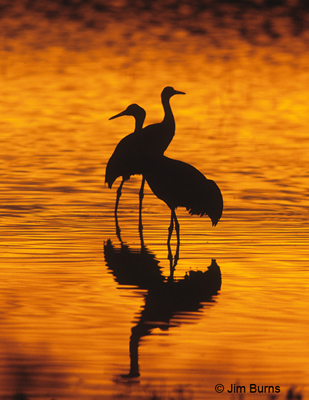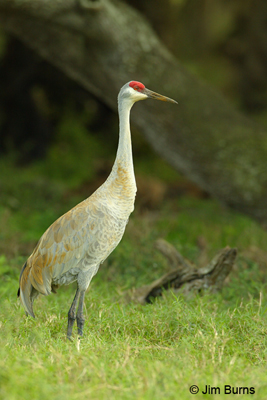
It is one of those concepts that is hard to verbalize but easy to recognize, and I knew immediately what he meant because I had just received a request for an image on our website from a lady who wanted a Sandhill Crane photo to put on the announcement of her fiftieth wedding anniversary. Not just one of my portraits of a Sandhill Crane but the image at the top of this column which evokes the eternal harmony and beauty of fifty years together in shared commitment—a visual adjective descriptive of a long and happy marriage. The sandhill image at the bottom of the column is a good photo, but it’s just a photographic record. A noun if you will.
I believe this same advice should also be taken to heart by birders who do not carry cameras, especially the ones for whom listing has become the primary reason they are in the field. Don’t go out just to put another checkmark on a list of species, but immerse yourself in the process—the research, the travel, the camaraderie with those who share your interests--then linger awhile for a chance to observe song, behavior, and lifestyle characteristics which make every species on the planet unique.
Arizona birders have recently been blessed for four days with a mega rarity even as a pair of uncommon range pioneers have again reappeared for nesting season. The White Wagtail and the Tufted Flycatchers undoubtedly attracted many of the “tick and run” crowd, but I hope all birders remember it was the common birds and the totality of the birding experience that first attracted them and informed their passion.
One morning in Florida, out for a run before first light, I heard a large flock of birds passing over or perhaps through the woods surrounding my friend’s house. The sound stirred my soul. These were birds on a mission, their soft but sharp nasal twittering breaking the velvet silence of the pre-dawn. The moment was made magical by the darkness, my inability to recognize the calls, and the size of the flock which took fully five minutes to pass--not a bird sighting, but a birding experience that seemed to me the essence of “adjective.”
Over breakfast my friend solved the mystery—Black-bellied Whistling-Ducks flying from their overnight roost to feed in a nearby wet prairie. I’ve seen small groups of Whistlers in Arizona, and I’ve heard calling pairs pass over in daylight around Patagonia. I’ve even seen a pair investigating a tree cavity for possible nesting, but I’ve never experienced this species as I did in Florida . . . without even “seeing” them. Adjectives are harder than nouns. They require time in the field and a bit of luck, but sometimes they happen without camera or binoculars. Go slowly, be mindful, open your heart and all your senses.